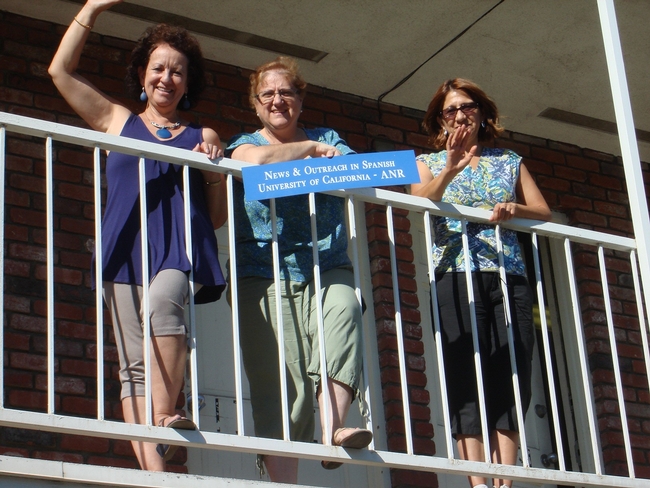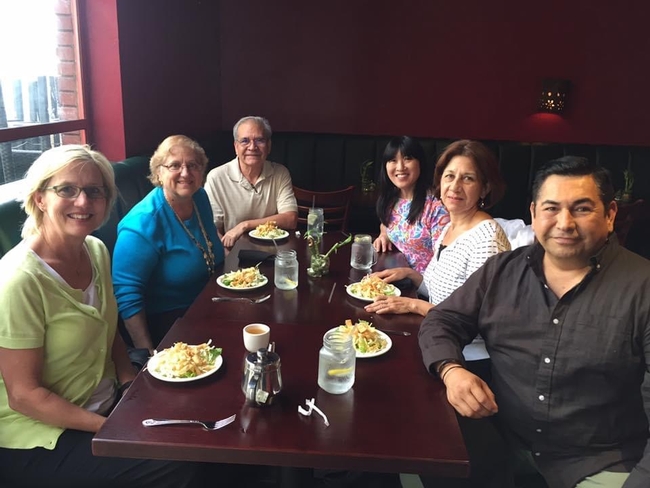Posts Tagged: broadcast
Lawn-pocalypse! Surviving Drought
Ah, summer! The season of sunburns, pool parties, and… lawn droughts. If your once lush, green carpet now looks like a crunchy brown doormat, you're not alone. Let's dive into why your yard is staging a dramatic death scene and what you can do to...

Bermuda grass and weeds overtaking drought stressed turf grass.
Norma De la Vega retires as broadcast communications specialist after 13 years
After 13 years of telling the UC ANR story through written articles and video production, Norma De la Vega retired on June 29. De la Vega joined UC ANR's News and Information Outreach in Spanish team in 2009 as a senior writer.
NOS fulfilled UC ANR's vision of developing educational and informational programs in Spanish to serve the Latino community. For more than 40 years, NOS has been producing information formatted for radio, television, and online audiences, and De la Vega has played an instrumental role in helping NOS expand its reach and diversify its creative approach to storytelling.
When she started, most of her writing focused on nutrition, highlighting groups like the Expanded Food and Nutrition Education Program and the Nutrition Policy Institute. “Norma's contributions were spot on,” said NOS Program Manager Ricardo Vela. “Her impact has been bringing the importance of nutrition into the stories that we bring to the community.”
De la Vega earned a bachelor's degree in science communications from Universidad Nacional Autónoma de México in her hometown of Mexico City. “Learning how to produce videos when I went to school was very different than now,” said De la Vega. “We didn't have the kind of cameras we do today.”
Following college, De la Vega worked as a television reporter in Tijuana before moving to San Diego County where she started focusing on writing. Prior to UC ANR, De La Vega worked as a writer for the Enlace Union-Tribune's Spanish newspaper in San Diego for nearly a decade.
Before it became NOS' primary medium for storytelling, De la Vega helped lead the team's video production effort despite her limited experience. “We weren't experts, but we realized the importance of video production to get our information out. It was a team effort,” she said.
In 2010, De la Vega wrote a story and produced a video on the importance of planning for old age. In many cases, adult children had to manage their parent's care without guidance, and most caregivers of the elderly spoke Spanish as their first language and needed more resources to do a better job.
De la Vega's story relied on research conducted by Patti Wooten Swanson, UCCE nutrition, family and consumer science advisor in San Diego. Not only was Swanson honored at the 2013 Galaxy Awards for her contribution to the story, but De la Vega, a member of the NOS team at the time, won first place at the Western Region Television/Video Communications Award Ceremony despite the lack of a Spanish language category.
In 2016, De la Vega produced a video of the first bilingual 4-H club, the result of a partnership with the Community Settlement Association in Riverside County. “A lot of good things were happening at that time and are happening now because ANR is evolving with more bilingual experts on different topics,” De la Vega said.
Although she started as a senior writer, De La Vega evolved and became a broadcast communications specialist. Her success in the role allowed her to become well-connected to other communicators and community leaders. “Norma always had a contact we needed for a story that we were working on,” said Miguel Sanchez, another broadcast communications specialist on the NOS team.
Lisa Rawleigh, NOS administrative assistant, established a personal and professional relationship with De la Vega. “Norma ensured that our Spanish articles were written properly and that we did not miss any accents or typos. I can always count on her to proofread my posts on social media,” said Rawleigh.
De la Vega said that she feels “enormously satisfied” to have worked with a team of fellow pioneers. “Although we were not experts, we learned so much every day and together,” De la Vega said. “Today, there are several experts in the production of community videos, and we helped enrich the graphic archive for UC ANR's community programs. I think our contribution was to lead the way in that direction.”
Looking ahead, De la Vega will be spending her retirement traveling and exploring other countries and cultures. Since she was a girl, De la Vega enjoyed swimming and can't wait to do more of it. “I love to swim because being in the water always makes me feel young,” she said.
Finally, De la Vega will enjoy quality time with her grandchildren, teaching them Spanish and volunteering at the Spanish immersion school they attend.
To read this story in Spanish, visit https://ucanr.edu/blogs/blogcore/postdetail.cfm?postnum=57440.
Climate-Change Resources
University of California UC ANR Green Blog (Climate Change and Other Topics) https://ucanr.edu/blogs/Green/index.cfm?tagname=climate%20change (full index)
Examples:
- Save Trees First: Tips to Keep Them Alive Under Drought https://ucanr.edu/b/~CdD
- Landscaping with Fire Exposure in Mind: https://ucanr.edu/b/~G4D
- Cities in California Inland Areas Must Make Street Tree Changes to adapt to Future Climate https://ucanr.edu/b/~oF7
Drought, Climate Change and California Water Management Ted Grantham, UC Cooperative Extension specialist (23 minutes) https://youtu.be/dlimj75Wn9Q
Climate Variability and Change: Trends and Impacts on CA Agriculture Tapan Pathak, UC Cooperative Extension specialist (24 minutes) https://youtu.be/bIHI0yqqQJc
California Institute for Water Resources (links to blogs, talks, podcasts, water experts, etc.) https://ciwr.ucanr.edu/California_Drought_Expertise/
UC ANR Wildfire Resources (publications, videos, etc.) https://ucanr.edu/News/For_the_media/Press_kits/Wildfire/ (main website)
-UC ANR Fire Resources and Information https://ucanr.edu/sites/fire/ (main website)
-Preparing Home Landscaping https://ucanr.edu/sites/fire/Prepare/Landscaping/
UC ANR Free Publications https://anrcatalog.ucanr.edu/ (main website)
- Benefits of Plants to Humans and Urban Ecosystems: https://anrcatalog.ucanr.edu/pdf/8726.pdf
-Keeping Plants Alive Under Drought and Water Restrictions (English version) https://anrcatalog.ucanr.edu/pdf/8553.pdf
(Spanish version) https://anrcatalog.ucanr.edu/pdf/8628.pdf
- Use of Graywater in Urban Landscapes https://anrcatalog.ucanr.edu/pdf/8536.pdf
- Sustainable Landscaping in California https://anrcatalog.ucanr.edu/pdf/8504.pdf
Other (Non-UC) Climate Change Resources
Urban Forests and Climate Change. Urban forests play an important role in climate change mitigation and adaptation. Active stewardship of a community's forestry assets can strengthen local resilience to climate change while creating more sustainable and desirable places to live. https://www.fs.usda.gov/ccrc/topics/urban-forests
Examining the Viability of Planting Trees to Mitigate Climate Change (plausible at the forest level) https://climate.nasa.gov/news/2927/examining-the-viability-of-planting-trees-to-help-mitigate-climate-change/
Reports and other information resources coordinated under the auspices of the United Nations and produced through the collaboration of thousands of international scientists to provide a clear and up to date view of the current state of scientific knowledge relevant to climate change. United Nations Climate Action
Scientific reports, programs, action movements and events related to climate change. National Center for Atmospheric Research (National Science Foundation)
Find useful reports, program information and other documents resulting from federally funded research and development into the behavior of the atmosphere and related physical, biological and social systems. Search and find climate data from prehistory through to an hour ago in the world's largest climate data archive. (Formerly the "Climatic Data Center") National Centers for Environmental Information (NOAA)
Think tank providing information, analysis, policy and solution development for addressing climate change and energy issues (formerly known as the: "Pew Center on Global Climate Change"). Center for Climate & Energy Solutions (C2ES)
Mapping Resilience: A Blueprint for Thriving in the Face of Climate Disaster. The Climate Adaptation Knowledge Exchange (CAKE) was launched in July 2010 and is managed by EcoAdapt, a non-profit with a singular mission: to create a robust future in the face of climate change by bringing together diverse players to reshape planning and management in response to rapid climate change. https://www.cakex.org/documents/mapping-resilience-blueprint-thriving-face-climate-disaster
Cal-Adapt provides a way to explore peer-reviewed data that portrays how climate change might affect California at the state and local level. We make this data available through downloads, visualizations, and the Cal-Adapt API for your research, outreach, and adaptation planning needs. Cal-Adapt is a collaboration between state agency funding programs, university and private sector researchers https://cal-adapt.org/
Find reports, maps, data and other resources produced through a confederation of the research arms of 13 Federal departments and agencies that carry out research and develop and maintain capabilities that support the Nation's response to global change. Global Change (U.S. Global Change Research Program)
The Pacific Institute is a global water think tank that combines science-based thought leadership with active outreach to influence local, national, and international efforts to develop sustainable water policies. https://pacinst.org/our-approach/
Making equity real in climate adaptation and community resilience policies and programs: a guidebook. https://greenlining.org/publications/2019/making-equity-real-in-climate-adaption-and-community-resilience-policies-and-programs-a-guidebook/
Quarterly CA Climate Updates and CA Drought Monitor Maps (updated each Thursday) https://www.drought.gov/documents/quarterly-climate-impacts-and-outlook-western-region-june-2022
Talking Good Fire: A Conversation with Drew Nelson
Forty acres of forestland- that's how much Drew Nelson and his wife lost during the Creek fire of 2020. “We had intentions of rebuilding there,” he told me, but “it was a really tough time after the fire.” They...
Drought focus of Water Resources IMPACT magazine special issue
UC ANR experts address emotional toll of drought
Preparing the American West for prolonged drought is the focus of a double issue of Water Resources IMPACT magazine. The California Water Commission staff are guest editors for this special open-access edition of the magazine, which is published by the American Water Resources Association.
Faith Kearns, academic coordinator of University of California Agriculture and Natural Resources' California Institute for Water Resources, is among the authors delving into how drought impacts people and the environment and how we can better prepare for the inevitable.
The first issue, published on Feb. 14, focuses on water scarcity issues confronting California and the ways these issues affect different sectors.
In “Trauma, Care, and Solidarity: Addressing the Emotional Toll of Chronic Drought,” Kearns highlights the effects of drought on mental health. She points to the spike in suicide hotline calls when wells ran dry in Southeast Asian communities in California's Central Valley.
By listening to Southeast Asian farmers, Ruth Dahlquist-Willard and Michael Yang of UC Cooperative Extension were able to “lighten the load” for them by providing pragmatic support, Kearns writes.
“The scale of some of these highly emotional issues – drought, wildfires, climate change – can make them seem incredibly difficult, if not impossible, to deal with,” Kearns said. “At the same time, they are affecting everyone living in the western U.S. on a daily basis. I wanted to highlight and provide models based on work that people – whether they are researchers, clinical psychologists, or Cooperative Extension advisors – are doing right now to ease the way.”
The authors who contributed to the double issue are a diverse array of Tribal experts, academics, nongovernmental organization thought-leaders, water managers and water policy influencers, each of whom brings their own perspective on the topic of drought. Their expertise and perspectives in climate science, water policy and water management will help inform drought-related decision-making and support policies that better prepare the state to thrive during periods of prolonged water scarcity.
In addition to Kearns, the first issue includes articles contributed by:
- Samantha Stevenson, University of California, Santa Barbara
- Jay Lund, University of California, Davis
- Ron Goode, North Fork Mono Tribe
- Andy Fecko, Placer County Water Agency
- Jeff Mount, Public Policy Institute of California, and Ted Grantham, University of California, Berkeley/UC Cooperative Extension
- Nat Seavy and Karyn Stockdale, National Audubon Society
- Kjia Rivers, Community Water Center
- Cannon Michael, Bowles Farming
- Michelle Reimers, Turlock Irrigation District
The January/February edition of Water Resources IMPACT magazine can be accessed, free of charge, on the American Water Resources Association website at https://www.awra.org under “Publications.”
The second issue, to be published in March, will focus on drought response, considering the options for adaptation. This two-part series complements the Commission's work on strategies to protect communities and fish and wildlife in the event of a long-term drought.






